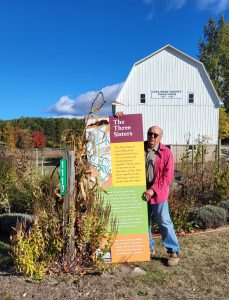
The Three Sisters
For millenniums corn, beans, and squash —the Three Sisters —have been planted together in a shared space. Corn comes up first, then the beans which use the corn stalks for support. As the bean
vines climb, the squash spreads along the ground to help keep weeds down and the soil cool and moist. The three plants work together physically and microbiologically.
Grow a Three Sisters Garden
Plant after the last frost when nighttime temperatures are at least 55°F, in a location with at least six hours of full sun each day.
Create a large mound of soil that’s 3–4’ wide and about 1’ tall, with a flat top about 10” in diameter.
Space mounds 4’ apart.
Plant 4–6 kernels of corn 1” deep in the flat part of the mound, spacing them 6–12” apart in a 2’ circle.
When the corn is 6–12 “tall, plant pole beans and squash around it.
Space the beans 3” from the corn and the squash along the outer edge of
the corn and beans.
Use cut branches or bamboo poles as supplemental support for the bean vines.
Throughout the growing season remove weeds, water weekly, and side dress with organic fertilizer.
Throughout History
The Three Sisters have been studied by scholars in anthropology, history, agriculture, and food
studies. Diohe’ko or the ThreeSisters had been cultivated for at least five hundred years prior to
contact by the Seneca, an Iroquoian tribe from New York State.
To the Iroquois people the Three Sisters were the physical and spiritual sustainers of life, given to the
people when they miraculously sprouted from the body of Sky Woman’s daughter, granting the gift of
agriculture to the Iroquois nations.
This planting technique spread from Mesoamerica northward becoming widespread throughout North
America. Indigenous farmers saved the best seeds for the following season, resulting in a wide
variety of cultivars perfectly suited for the environments in which they were grown. Much of this
diversity was sadly lost as indigenous nations were forced out of their ancestral lands by early
European settlers and mainstream agricultural practices took h

